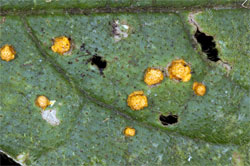Coffee: rust never sleeps
Tuesday, January 22, 2013

Prices of arabica coffee, the high-quality grains produced in Central America, have risen to their highest prices in two months in New York and London.
That should be good news for farmers and exporters in the region, but the reverse is true.
The increase in prices is due to expectations that between 10 and 20 percent of the current Central American crop will likely be lost, due to a blight known as coffee rust.
That means substantial losses for large-scale growers, though most of them should be able to shoulder the burden by replanting with disease-free plants and setting up shading systems to protect them.
The situation is likely to be more severe for the region's 250,000 or so small growers, who may not be able to afford the costs of replanting.
In all, coffee employs 1.5 million Central Americans and, despite a recent decline in prices, the latest cycle earned a total of $3.6 billion.
The fungus - Hemileia vastatrix - is known as rust because of the ochre color of the affected plants, whose beans have to be thrown out.
Just as the poor farmers are likely to be the hardest hit, so too are the poorest countries.
Coffee is the main export of Honduras and Nicaragua, with earnings of about $1.4 billion and more than $500,000, respectively.
Half of Guatemala's crop may be infected, and about 30 percent of El Salvador's.
Costa Rica and Panama have similar problems, though their overall economies are much stronger.
A significant injection of aid for the region's growers would help.
But in today’s economic climate, this is not likely to happen.
